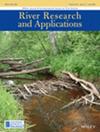应用亲子鉴定法检测砾石增殖对大鳞大麻哈鱼幼鱼招募率的影响
IF 1.9
4区 环境科学与生态学
Q4 ENVIRONMENTAL SCIENCES
引用次数: 0
摘要
对栖息地恢复对鲑鱼繁殖性能的影响进行量化测量是有限的,尽管这对评估管理措施是否会引起种群反应是必要的。我们研究了使用近亲标记再捕获方法,在幼鱼离开原生地的标准监测指标中划分恢复效果。通过这种方法,我们可以统计比较在一条高度管理的加州河流的砾石增殖(修复)和非增殖(未修复)河段自然繁殖的大鳞大麻哈鱼(Oncorhynchus tshawytscha)的相对幼鱼捕获率(招募)。基因亲子鉴定技术将在增殖和非增殖产卵栖息地产卵的成年雌性大鳞大麻哈鱼与第二年春季在产卵区下方的诱捕器采样的幼年大鳞大麻哈鱼联系起来。增殖和非增殖栖息地都有成功繁殖的记录,两种栖息地之间没有统计学差异。与在其他系统中观察到的捕获率相比,每条成年雌性大马哈鱼的捕获率较低(0.19-0.24 条幼鱼/条雌性大马哈鱼)。在采集的幼鱼中,大多数雌性幼鱼只有 0 或 1 个后代被观察到;但是,有一只在恢复栖息地产卵的雌性幼鱼在诱捕器中发现了 25 个后代。我们模拟了幼鱼捕获率与一系列生物和环境变量的关系,包括产卵栖息地地点、产卵栖息地处理(增殖和非增殖)、年产卵者丰度、产卵年份、雌鱼叉长、产卵和孵化日以及流量最大值和方差。每年的成鱼丰度(通过胴体调查获得的逃逸量)与招募量(诱捕器中的幼鱼回收量)之间存在反比关系,这表明栖息地限制可能会产生密度依赖效应。此外,雌性个体大小与繁殖量呈正相关,而产卵日和日平均气温与繁殖量呈反相关,这表明生物和环境因素对繁殖潜力的影响与栖息地无关。这项研究提供的证据表明,栖息地恢复可对繁殖率产生叠加(递增)的积极影响,从而为孵化场管理和与种群恢复相关的恢复活动提供信息。本文章由计算机程序翻译,如有差异,请以英文原文为准。
Applying parentage methods to detect gravel augmentation effects on juvenile Chinook Salmon recruitment rates
Quantifiable measurement of habitat restoration effects on salmonid reproductive performance is limited, although it is necessary for evaluating whether population responses follow management actions. We investigated using close‐kin mark‐recapture methods to partition restoration effects within standard monitoring metrics of juvenile emigrants leaving the natal reach. This approach allowed for statistical comparison of relative juvenile capture rates (recruitment) from Chinook Salmon (Oncorhynchus tshawytscha ) naturally reproducing in gravel augmented (restored) and nonaugmented (unrestored) reaches of a highly managed California River. Genetic parentage techniques linked adult females that had spawned in augmented and nonaugmented spawning habitats with juvenile Chinook Salmon sampled the following spring at a trap located below the natal spawning area. Successful recruitment was documented from both augmented and nonaugmented habitats, with no statistical difference between the two habitat types. The capture rate per adult female was low (0.19–0.24 juveniles/female) compared to rates observed in other systems. Within the juvenile collections, most females in the study had 0 or 1 offspring observed; however, one female that spawned in a restored habitat had 25 offspring recovered at the trap. We modeled juvenile capture rates in relation to a range of biological and environmental variables including spawning habitat site, spawning habitat treatment (augmented and nonaugmented), annual spawner abundance, year spawned, female fork length, spawning and hatch day, and flow maximum and variance. There was an inverse relationship between annual adult abundance (escapement obtained from carcass surveys) and recruitment (juvenile recoveries at trap), suggesting habitat limitation may be creating density‐dependent effects. Additionally, female body size was positively associated with recruitment, while spawning day and mean daily temperature were inversely associated with recruitment, suggesting that both biological and environmental factors independent of habitat influenced reproduction potential. This study provides evidence that habitat restoration could have an additive (incremental) positive effect on recruitment rate, informing hatchery management and restoration activities related to population recovery.
求助全文
通过发布文献求助,成功后即可免费获取论文全文。
去求助
来源期刊

River Research and Applications
环境科学-环境科学
CiteScore
4.60
自引率
9.10%
发文量
158
审稿时长
6 months
期刊介绍:
River Research and Applications , previously published as Regulated Rivers: Research and Management (1987-2001), is an international journal dedicated to the promotion of basic and applied scientific research on rivers. The journal publishes original scientific and technical papers on biological, ecological, geomorphological, hydrological, engineering and geographical aspects related to rivers in both the developed and developing world. Papers showing how basic studies and new science can be of use in applied problems associated with river management, regulation and restoration are encouraged as is interdisciplinary research concerned directly or indirectly with river management problems.
 求助内容:
求助内容: 应助结果提醒方式:
应助结果提醒方式:


